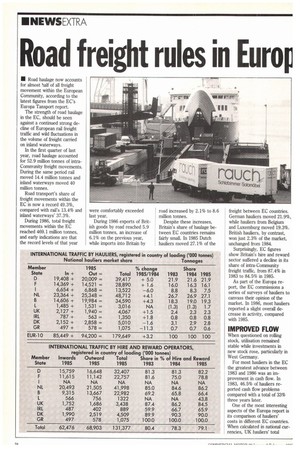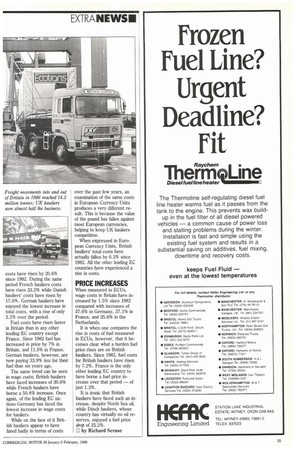Road freight rules in Europ
Page 26

Page 27

If you've noticed an error in this article please click here to report it so we can fix it.
• Road haulage now accounts for almost half of all freight movement within the European Community, according to the latest figures from the EC's Europa Tansport report.
The strength of road haulage in the EC, should be seen against a continued strong dedine of European rail freight traffic and wild fluctuations in the volume of freight carried on inland waterways.
In the first quarter of last year, road haulage accounted for 52.9 million tonnes of intraCommunity freight movements. During the same period rail moved 14.4 million tonnes and inland waterways moved 40 million tonnes.
Road transport's share of freight movements within the EC is now a record 49.3%, compared with rail's 13.4% and inland waterways' 37.3%.
During 1986, total freight movements within the EC reached 469.1 million tonnes, and early indications are that the record levels of that year were comfortably exceeded last year.
During 1986 exports of British goods by road reached 5.9 million tonnes, an increase of 6.1% on the previous year, while imports into Britain by road increased by 2.1% to 8.6 million tonnes.
Despite these increases, Britain's share of haulage between EC countries remains fairly small. In 1985 Dutch hauliers moved 27.1% of the freight between EC countries. German hauliers moved 21.9%, while hauliers from Belgium and Luxemburg moved 19.3%. British hauliers, by contrast, won just 2.3% of the market, unchanged from 1984.
Surprisingly, EC figures show Britain's hire and reward sector suffered a decline in its share of intra-Community freight traffic, from 87,4% in 1983 to 84.5% in 1985, As part of the Europa report, the EC commissions a series of surveys of hauliers to canvass their opinion of the market. In 1986, most hauliers reported a slight overall decrease in activity, compared with 1985.
When questioned on rolling stock, utilisation remained stable while investments in new stock rose, particularly in West Germany.
For most hauliers in the EC the greatest advance between 1983 and 1986 was an improvement in cash flow. In 1983, 46.5% of hauliers reported cash flow problems compared with a total of 33% three years later.
One of the most interesting aspects of the Europa report is its comparison of hauliers' costs in different EC countries. When calculated in national currencies, UK hauliers' total costs have risen by 20.6% since 1982. During the same period French hauliers costs have risen 33.2% while Danish hauliers' costs have risen by 17.8%. German hauliers have enjoyed the lowest increase in total costs, with a rise of only 2.2% over the period.
Fuel costs have risen faster in Britain than in any other leading EC country except France. Since 1982 fuel has increased in price by 7% in Britain, and 11.5% in France. German hauliers, however, are now paying 33.9% less for their fuel than six years ago.
The same trend can be seen in wage costs; British hauliers have faced increases of 30.6% while French hauliers have borne a 50.8% increase. Once again, of the leading EC nations Germany has faced the lowest increase in wage costs for hauliers.
While on the face of it British hauliers appear to have fared badly in terms of costs over the past few years, an examination of the same costs in European Currency Units produces a very different result. This is because the value of the pound has fallen against most European currencies, helping to keep UK hauliers competitive.
When expressed in European Currency Units, British hauliers' total costs have actually fallen by 6.2% since 1982. All the other leading EC countries have experienced a rise in costs.
When measured in ECUs, wage costs in Britain have increased by 1.5% since 1982 compared with increases of 37.6% in Germany, 37.1% in France, and 35.6% in the Netherlands.
It is when one compares the rise in costs of fuel measured in ECUs, however, that it becomes clear what a burden fuel price rises are on British hauliers. Since 1982, fuel costs for British hauliers have risen by 7.2%. France is the only other leading EC country to have borne a fuel price increase over that period — of just 1.3%.
It is ironic that British hauliers have faced such an increase, despite North Sea oil, while Dutch hauliers, whose country has virtually no oil reserves, enjoyed a fuel price drop of 25.2%.
ID by Richard Scrase
























































































